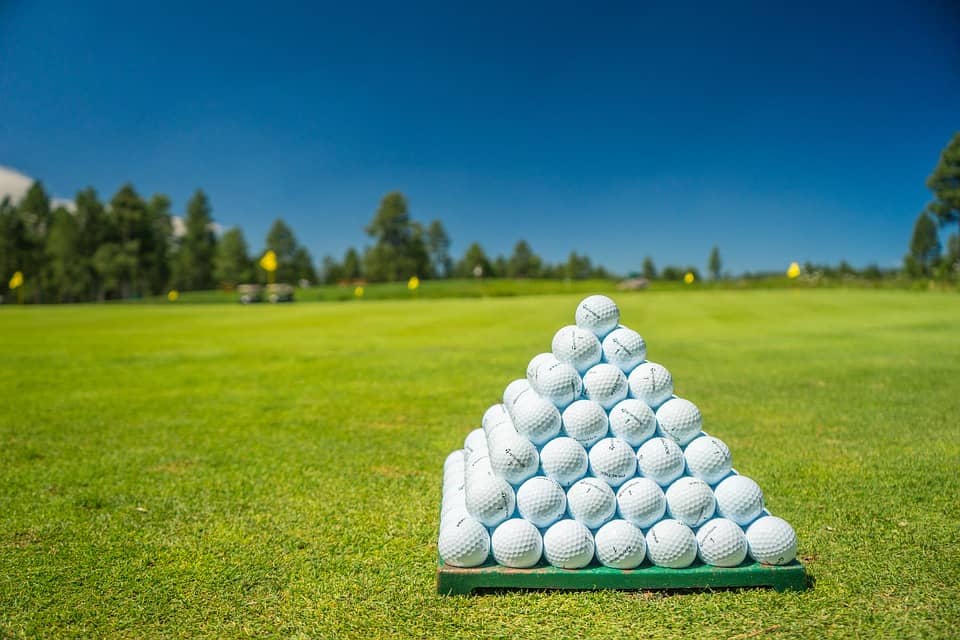
The Evolution of the Modern Golf Ball
Since the start of the 20th century, most golf balls were made with solid rubber or liquid core encased by a tightly wound band of elastic rubber. Ball covers were constructed from a thin layer of balata sap, a thick liquid derived from the balata tree.
The 1960s saw the century’s first major golf ball manufacturing change, with the introduction of covers made from Surlyn, a synthetically produced resin, and urethane, a durable, manufactured polymer. Soon thereafter, golf ball makers began to experiment with an array of dimple configurations on the ball’s outer surface, as well as a variety of internal construction techniques. Out of those efforts came the different ball types we know today. Let’s look at the best and most common of these types.
Types of Golf Balls
Wound Balls
Wound balls are still in use today even though they are not currently manufactured by the leading golf ball makers. These balls contain a hard or liquid center core surrounded by tightly wound rubber strands. They became popular because of their superior control and “feel”, though more recently developed solid and multi-piece balls also perform well in those areas.
Solid Core Construction Balls
One-piece, or solid core, balls contain a single, sold rubber core surrounded by urethane or surlyn cover. The solid structure of these balls does not compress when struck like multi-layer balls, causing them to not travel as far. These balls also do not spin as easily as other ball types, and therefore tend to fly in a straighter direction when hit off-center. This quality reduces the severity of hooks or slices and makes the ball an ideal choice for the beginning or occasional golfer.
Three Piece Hybrid Balls
These golf balls are made with a solid inner core, surrounded by a second layer. The ball’s cover is made from either surlyn or urethane. Like most multi-layered balls, three-piece golf balls compress when impacted, producing more distance-generating energy than solid core balls.
While they fly farther than solid core balls, they’re also more apt to slide on the clubface surface when struck. Since this makes them spin more easily, experienced golfers generally prefer multi-layered construction.
The increased spin improves their ability to bend shots around hazards and precisely place balls on greens. On the other hand, recreational or weekend golfers may find the balls difficult to control, since hooking or slicing actions will be magnified.
Four Piece Hybrid Balls
These balls are similar in structure to three-piece balls. The major difference is that the inner core is split into two separate layers. This two-piece inner core is encased in a thinner third layer, which is surrounded by the ball’s outer surlyn or urethane cover. While these balls possess the same performance characteristics as three-piece balls, their compression at impact is greater and the tendency to slide across the clubface is more pronounced.
This makes them ideal for experienced amateurs and professionals, whose games depend on generating distance off the tee, curving shots around trees or other hazards, and generating back and sidespin on the green.
Four-piece balls are a bad choice for casual golfers or beginners. They’re generally expensive and cause mishit balls to fly farther in the wrong direction. Beginners using these balls may find themselves losing lots of pricey golf balls and ending the day in a decidedly frustrating state.
Exterior Designs
We’ve thus far focused on the different internal structure of golf balls. Let’s now take a look at three different exterior designs. Today’s golf ball contains dimples, or indentations, on its surface. This is the result of centuries of experimentation, which showed that smooth-surfaced balls traveled more unpredictably through the air than balls with consistent surface features.
A consistent, dimpled surface creates a layer of air turbulence around the ball in flight, which reduces drag and increases flight stability.
Round Dimples in Moderate Numbers
The vast majority of moderately priced to high-end balls sold today have between 300 and 500 identical, round dimples on their surface. The limited research performed to date does not show a material difference in flight of balls within this range. Therefore, when purchasing most commonly sold balls, golfers need not be concerned with the number of dimples.
Round Dimples in Higher Numbers
While research on dimple numbers versus performance is limited, there is general consensus that too many dimples could affect a ball’s flight under certain conditions. An overabundance of surface features on any airborne object causes the air around the object’s surface to become unstable, and a loss of control results.
The exact line of demarcation for a golf ball isn’t precisely known. Balls with more than 500 dimples can be purchased, but it is thought that there is little or no benefit from doing so. Balls have been produced with over 1,000 dimples, but they are not widely available and are well out of the mainstream of golf ball production.
Dimples of Different Shapes
Some manufacturers have produced golf balls with hexagonal shaped dimples. This is based on the theory that a hexagonal shape better regulates the air around a ball, and makes the ball less prone to the effects of cross-winds. In fact, some testing has shown such balls to be more stable in flight under certain conditions. Whether this produces better outcomes for the average golfer is questionable.
The Choices are Many
Today’s golfers have access to the widest variety of ball types and designs ever. Most all currently produced golf balls are made with one of the design types noted here, and almost any level of golfer can find the ball type that’s right for him or her. The main thing is to get out and enjoy the game. BrandMe can help. We can show you countless to enjoy your game more by making all your golfing accessories uniquely yours!










